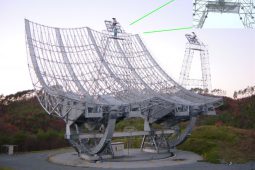PPARCセミナー (2022/12/02)

PPARCセミナー 2022/12/02
発表者: 風間暁 (M2)
タイトル: Development of a tool for surface pressure retrievals on Mars by CO2 2μm absorption band ~ Mars Express/OMEGA observation and future MMX/MIRS application ~
アブスト: To understand atmospheric variability on Mars, the distribution of surface pressure is important. Since Mars has a large orbital eccentricity, solar radiation fluctuates by more than 30% per year. As a result, large global and mesoscale variations are caused by the condensation and sublimation of CO2 and H2O and the local and seasonal variations of dust. On Earth, the distribution of surface pressure can be obtained by many observation points on the ground. However Mars only has a few numbers of landers at specific locations, so the horizontal distribution of the surface pressure has been poorly understood. global surface pressure distribution of Mars can only be delivered from the orbiter data. Forget et al. (2007) and Spiga et al. (2007) are the only examples of the successful derivation of mesoscale surface pressure distribution. In this trial, the surface pressure was retrieved from the near-infrared CO2 absorptions at 2 um taken by OMEGA onboard Mars Express (MEx) during its initial observation (2004-2005). The CO2 mixing ratio in the lower Martian atmosphere (well known as 0.9532 in early summer obtained by the Viking Lander mass spectrometer) can be assumed as uniform in altitude, and we can assume that the surface pressure is in proportion to the CO2 column density when the atmosphere is hydrostatic. In this previous case, only ideal data (e.g., no aerosol scattering, etc.) were used, and only about 0.7% of the total data (29 out of about 4,000 nadir observations) were utilized. From those limited data sets, the pressure distribution over 95 x 150 km (2.5 deg in longitude, 4 deg in latitude) could be derived and succeeded to show the pressure gradients and atmospheric waves. The near-infrared spectrometer MIRS onboard the Martian Moons eXploration (MMX) mission, which is scheduled for launch in 2024, will be able to observe a wide area in the mid-to low-latitudes in one-hour intervals by using the scanner mirror of the instrument and the maneuver operation of the spacecraft. Continuous observations of the mid-and low-latitude Martian atmosphere are planned from its orbit around Phobos. We have tried to make use of this capability to retrieve a wide-area surface pressure distribution. We first retrieve the mesoscale surface pressure from the entire period of MEx/OMEGA observations (2004-2010) in its SWIR (near-infrared) channel 1.8-2.2 um (25 points, wavelength resolution ~20 nm). Following the method adopted by Forget et al. (2007) and Spiga et al. (2007), the CO2 column density is used for the estimation of the surface pressure with surface altitude correction. Eight physical parameters (atmospheric pressure, temperature, surface albedo, dust opacity, water ice, solar zenith angle, solar viewing angle, and phase azimuth angle) can affect the observed spectra. Therefore, at first, we prepared ~4,520,000 cases of calculated spectra based on the HITRAN2020 database, calculated with the radiative transfer code ARS (Ignatiev et al, 2005). Using this spectral table, surface pressure could be quickly retrieved by matching the calculated spectra and the observed one, by the maximum likelihood estimation method. In this presentation, we will report the status of and results from our surface pressure derivation system adopted for MEx/OMEGA.
発表者: 坂野井健 (Staff)
タイトル: Vertical profile of optical aurora caused by high-energy electrons obtained with the LAMP rocket
アブスト: We report the results of a multi-spectral auroral camera AIC installed on the LAMP rocket which was successfully launched from Poker Flat at 11:27:30 UT on March 5, 2022. AIC measured two auroral emissions mainly in the E-region at 670 nm (N2 1PG) and in the F-region at 844.6 nm (OI) using 2 CMOS cameras called AIC1 and AIC2. Two cameras take images simultaneously with a time resolution of ~10 frame/s. AIC1 is pointed to the magnetic footprint with a FOV of 29 deg x 29 deg which covered 180 km x 180 km with a resolution of 3 km x 3 km at the apex altitude (~430 km altitude). FOV of AIC2 is φ106 deg circle which covered the wide range from the nadir to the limb of the Earth. AIC is mounted on the despun table to cancel the rocket spin and obtain stable line-of-sight directions of FOVs. At ~10:30 UT on March 5, 2022, a typical auroral break up with a negative excursion of geomagnetic east-west component of ~500 nT (Kp=4-) happened at Poker Flat, and afterward significant pulsating auroral patches with internal modulations with several Hz appeared in the northward sky. The LAMP rocket was successfully launched into and flew over the pulsating auroral patches. AIC worked satisfactorily as expected throughout the flight. For the flight time after the launch from ~90 s to the end of flight (~620 s), the despun table worked correctly and small-scale auroral images were continuously obtained by AIC above the auroral emission layer for the first time. On the other hand, AIC observed the in-situ auroral intensities when the rocket was in the emission layers in E- and F-region, respectively. Other PARM instruments and ground-based high-speed imagers at Poker Flat, Venetie, and Fort Yukon succeeded to observe during the flight. In this talk, we give the initial results of vertical profile of N2 1PG aurora and its comparison with the electron data.





